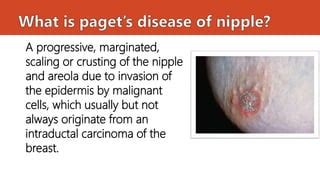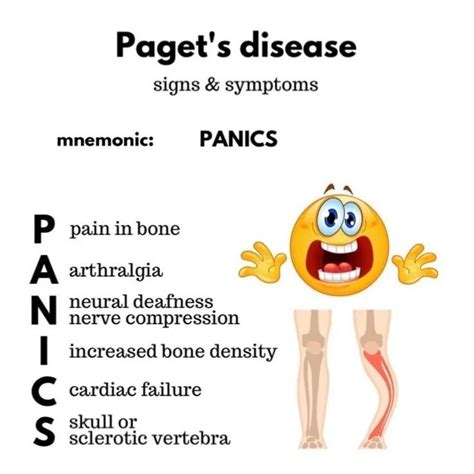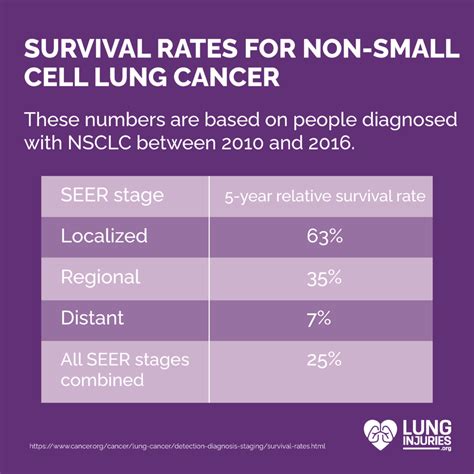Intro
Paget's disease of the nipple is a rare and often misunderstood condition that affects the skin of the nipple and, sometimes, the areola. It is essential to understand the importance of this topic, as it can be a sign of an underlying breast cancer. The disease is named after Sir James Paget, who first described it in 1874. Despite its rarity, Paget's disease of the nipple is a crucial aspect of breast health, and being informed about its symptoms, diagnosis, and treatment options can help individuals take control of their well-being.
The significance of Paget's disease of the nipple lies in its potential to be a warning sign for breast cancer. According to the American Cancer Society, Paget's disease of the nipple is often associated with an underlying ductal breast cancer, either in situ or invasive. This means that it is crucial to seek medical attention if symptoms persist or worsen over time. Early detection and diagnosis can significantly improve treatment outcomes and overall prognosis. Furthermore, understanding the risk factors and causes of Paget's disease of the nipple can help individuals take preventive measures and maintain good breast health.
Paget's disease of the nipple is a complex condition that requires a comprehensive approach to diagnosis and treatment. The disease can manifest in different ways, and its symptoms can be similar to those of other skin conditions, making it challenging to diagnose. However, with the help of advanced diagnostic techniques and a thorough understanding of the disease, healthcare professionals can provide effective treatment options and improve patient outcomes. In this article, we will delve into the world of Paget's disease of the nipple, exploring its causes, symptoms, diagnosis, treatment options, and more.
What is Paget's Disease of the Nipple?

Causes and Risk Factors
The exact causes of Paget's disease of the nipple are still not fully understood. However, research suggests that it is often associated with an underlying breast cancer, either in situ or invasive. Other risk factors include: * Family history of breast cancer * Previous radiation therapy to the breast * Presence of BRCA1 or BRCA2 gene mutations * Aging, as most cases occur in women over 50 years old * Presence of other breast conditions, such as ductal carcinoma in situ (DCIS)Symptoms of Paget's Disease of the Nipple

Diagnosis and Staging
Diagnosing Paget's disease of the nipple can be challenging, as its symptoms can be similar to those of other skin conditions. A thorough physical examination, medical history, and diagnostic tests are essential to confirm the diagnosis. Tests may include: * Mammography * Ultrasound * Magnetic resonance imaging (MRI) * Biopsy of the affected skin * Sentinel lymph node biopsyTreatment Options for Paget's Disease of the Nipple

Managing Symptoms and Side Effects
Managing symptoms and side effects is crucial to improving quality of life during treatment. This may include: * Pain management * Wound care * Skin care * Emotional support * Lifestyle modifications, such as diet and exercisePrognosis and Survival Rates

Current Research and Future Directions
Research is ongoing to improve our understanding of Paget's disease of the nipple and to develop more effective treatment options. Current studies focus on: * Identifying genetic markers and risk factors * Developing new diagnostic techniques * Improving treatment outcomes and reducing side effects * Exploring the role of immunotherapy and targeted therapyConclusion and Final Thoughts

What are the symptoms of Paget's disease of the nipple?
+The symptoms of Paget's disease of the nipple include redness and itching of the nipple and areola, discharge or bleeding from the nipple, crusting or scaling of the skin, flattening or inversion of the nipple, changes in the shape or size of the nipple, and presence of a lump or mass in the breast.
How is Paget's disease of the nipple diagnosed?
+Paget's disease of the nipple is diagnosed through a combination of physical examination, medical history, and diagnostic tests, such as mammography, ultrasound, MRI, biopsy of the affected skin, and sentinel lymph node biopsy.
What are the treatment options for Paget's disease of the nipple?
+Treatment options for Paget's disease of the nipple depend on the underlying cause and the extent of the disease and may include surgery, radiation therapy, chemotherapy, hormone therapy, targeted therapy, and combination therapy.
We hope this article has provided you with a comprehensive understanding of Paget's disease of the nipple. If you have any further questions or concerns, please do not hesitate to comment below or share this article with others. Remember, early detection and diagnosis are crucial to improving treatment outcomes and survival rates. Stay informed, stay vigilant, and take control of your breast health today!
